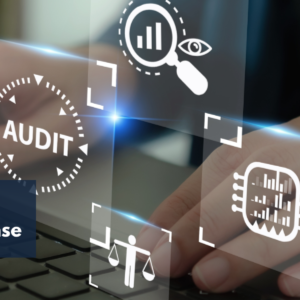This is the seventh and final blog post for NanoMatriX’s AI Governance Series.
Artificial Intelligence is reshaping industries, from healthcare to finance, delivering unprecedented efficiencies and insights. However, with great potential comes significant risk. A 2024 study estimates that the global AI market could exceed $500 billion annually, but nearly 15% of business leaders cite ethical and compliance risks as their top concerns when implementing AI systems.
Recent failures emphasize the importance of managing AI risks. For example, an AI recruitment tool was found biased against women, and AI-driven credit scoring systems have been flagged for racial discrimination. These incidents highlight why businesses must prioritize risk management and compliance. Failing to do so can lead to reputational damage, legal consequences, and financial losses.
This article offers a roadmap for AI risk management and compliance to ensure your systems are innovative and responsible.
Understanding AI Risk Management
AI risk management involves identifying, assessing, and mitigating potential risks associated with AI systems. It ensures these systems operate reliably, ethically, and in compliance with regulations.
Here are the main types of risks:
- Operational Risks: These include system failures, incorrect predictions, or errors in decision-making. For example, a faulty AI algorithm in 2023 misdiagnosed thousands of patients, delaying critical treatments.
- Ethical Risks: Bias and unfair decision-making are common concerns. In one case, an AI-powered hiring platform systematically rejected resumes from minority groups due to biased training data.
- Compliance Risks: Non-adherence to local and international regulations can result in fines. For instance, the European Union’s GDPR imposes fines of up to €20 million for data privacy violations.
Real-world events underscore the need for businesses to implement robust AI risk management frameworks. Companies can avoid costly mistakes by addressing these risks while building trust with users and stakeholders.
The Role of Compliance in Building Trustworthy AI Systems
Regulations governing AI are rapidly evolving. Frameworks like ISO 42001, which focuses on AI management systems, and laws such as the European Union’s AI Act are setting global standards. These regulations ensure AI systems are transparent, fair, and accountable.
Here is why compliance matter:
- Mitigating Legal Risks: Non-compliance can result in hefty fines and lawsuits.
- Building Trust: Businesses that comply with ethical standards are more likely to gain public confidence. GENESYS mentions that 84% of consumers consider ethical AI a key factor when choosing a product or service.
- Driving Innovation: Compliance frameworks encourage better design and risk management, enabling businesses to innovate responsibly.
Organizations that prioritize compliance can navigate regulatory complexities while maintaining their competitive edge.
Key Strategies for Effective AI Risk Management
Risk assessments are the cornerstone of effective AI risk management. They involve identifying potential vulnerabilities and evaluating their impact.
Step 1: Map out the AI system’s functionalities and potential risks.
Step 2: Assess the likelihood and severity of each risk. For instance, what is the impact of biased data on decision-making?
Step 3: Use tools like risk heat maps to prioritize high-risk areas.
Implementing Risk Treatment Plans
Once risks are identified, businesses must develop and execute treatment plans.
- Mitigation Measures: Address vulnerabilities by improving data quality, refining algorithms, or incorporating human oversight.
- Ongoing Evaluation: Regularly test AI systems to ensure risks remain under control. For example, a financial institution uses monthly audits to monitor AI-driven loan approvals for fairness.
Bridging Risk Management and Compliance
Risk management and compliance are interconnected. By addressing risks, businesses inherently support compliance efforts. Here’s how the two align:
- Risk Assessments: Conducting regular assessments helps businesses identify vulnerabilities and align with regulatory requirements.
- Impact Analyses: Evaluating how AI systems affect users ensures ethical decision-making and compliance with fairness guidelines.
- Documentation: Maintaining detailed records of risk evaluations and mitigation efforts demonstrates transparency to regulators.
For instance, a financial institution reduced regulatory penalties by implementing a strong risk management framework that integrated compliance measures. This approach not only addressed vulnerabilities but also ensured adherence to legal standards.
Continuous Monitoring and Auditing
Risk management does not end after implementation; continuous monitoring is vital. Organizations should regularly audit their AI systems to ensure they comply with regulations and perform as intended. This includes:
- Conducting regular reviews of algorithms for bias.
- Monitoring data usage to ensure compliance with privacy laws.
- Assessing the effectiveness of risk treatment plans.
By maintaining vigilance, companies can quickly adapt to new challenges as they arise.
Stakeholder Engagement and Ethics
Engaging stakeholders, employees, customers, and regulators is essential in developing effective risk management strategies. Companies should promote open communication about how they use AI technologies and address stakeholders’ concerns.
Moreover, ethical considerations should guide decision-making processes related to AI deployment. Companies must ensure that their use of AI aligns with societal values and does not perpetuate discrimination or harm vulnerable populations.
Steps to Achieve AI Risk Management and Compliance
Achieving AI risk management and compliance requires a structured and proactive approach. Here are the key steps businesses can take:
- Conduct Regular Risk Assessments: Identify risks in AI systems, such as data inaccuracies, algorithmic biases, and security vulnerabilities. Tools like risk matrices can help prioritize these risks based on their potential impact and likelihood.
- Develop Risk Treatment Plans: Once risks are identified, create actionable plans to mitigate them. For instance, addressing algorithmic bias may involve retraining models with diverse datasets. Regular updates and testing ensure systems remain reliable and fair over time.
- Stay Updated on Regulations: AI laws and compliance standards evolve rapidly. Assign a dedicated compliance officer or team to track updates to local and international regulations, such as GDPR and the EU AI Act. This ensures businesses can adapt their practices promptly.
- Perform Impact Assessments: Evaluate the broader societal, ethical, and environmental impacts of AI systems. For example, consider how decisions made by AI affect different demographic groups. Conducting impact assessments helps identify unintended consequences and align systems with ethical standards.
- Document and Audit Processes: Maintain comprehensive documentation of all risk assessments, mitigation strategies, and compliance efforts. This not only demonstrates accountability to regulators but also builds trust with stakeholders. Regular internal and external audits ensure that systems continue to meet compliance requirements.
By implementing these steps, businesses can minimize risks, enhance system reliability, and maintain compliance with evolving standards. A proactive approach to risk management and compliance is essential for fostering trust and ensuring the successful adoption of AI technologies.
The Need for Continuous Learning and Adaptation
AI technologies evolve rapidly, introducing new opportunities and risks. Similarly, regulations governing AI continue to change as governments and organizations address its ethical, legal, and societal implications. This dynamic landscape makes continuous learning and adaptation essential for businesses using AI systems.
Invest in Training
Investing in regular training programs is one effective way for companies to stay ahead. For example, businesses can offer workshops on AI governance, risk management, and compliance standards like GDPR and ISO 42001. Such training equips employees with up-to-date knowledge to identify risks and implement necessary safeguards. A Harvard business review mentions that companies prioritizing training see a 30% increase in their teams’ ability to adapt to regulatory shifts.
Leverage New Tools
Another critical component is adopting advanced tools that streamline compliance and risk management. AI-powered monitoring systems can help detect biases, vulnerabilities, or deviations from regulatory requirements in real-time. These tools not only save time but also ensure that businesses remain compliant amidst shifting regulations.
Foster Cross-Functional Collaboration
Cross-functional collaboration is equally important. Encouraging technical teams, compliance officers, and legal experts to work together ensures risks are addressed holistically. For example, financial institutions often conduct joint reviews of their AI systems to identify potential regulatory gaps and mitigate risks effectively.
Monitor Trends
Keeping a close eye on emerging trends and regulations can future-proof AI systems. By proactively adapting to changes, businesses can mitigate risks, maintain compliance, and build trust with stakeholders in an increasingly AI-driven world. Continuous learning and adaptability are not just strategies—they are necessities for sustainable success in the fast-changing AI landscape.
Master AI Risk Management and Compliance with NanoMatriX!
Dealing with the complexities of AI risk management and compliance requires the right knowledge and strategies. NanoMatriX’s Risk Management and Compliance in AI Systems course is designed to help businesses and professionals stay ahead in this critical area.
This 2-hour online program offers practical tools and actionable insights to help you:
- Identify and Assess Risks: Learn how to conduct practical risk assessments to uncover potential vulnerabilities in AI systems.
- Implement Risk Treatment Plans: Develop strategies to mitigate risks, from addressing algorithm biases to safeguarding data privacy.
- Understand AI Regulations: Gain a clear understanding of local and international AI laws, including how to ensure your systems comply with emerging standards.
- Apply Real-World Examples: Explore real-world case studies to understand the impact of risk management on business operations and stakeholder trust.
Who Should Enroll?
- Business leaders aiming to implement AI responsibly.
- Compliance officers looking to enhance their understanding of AI regulations.
- Professionals eager to build a career in AI risk management and compliance.
This two-hour online course is packed with knowledge, designed to fit into your busy schedule while delivering maximum impact. With limited seats available, now is the time to take the first step toward mastering AI risk management.
Don’t wait to safeguard your AI systems. Enroll now to master AI risk management and compliance strategies.
Learn More and Secure Your Spot Today!















Recent Comments